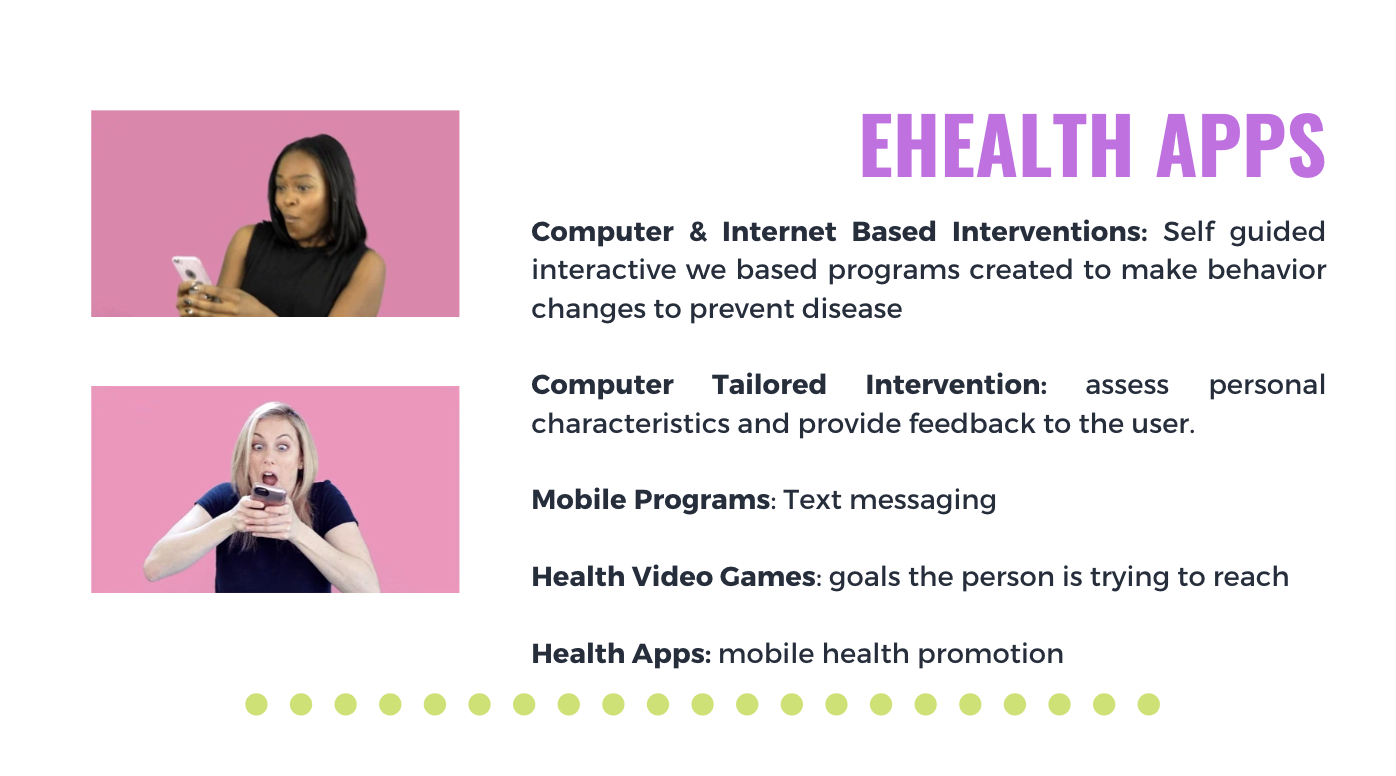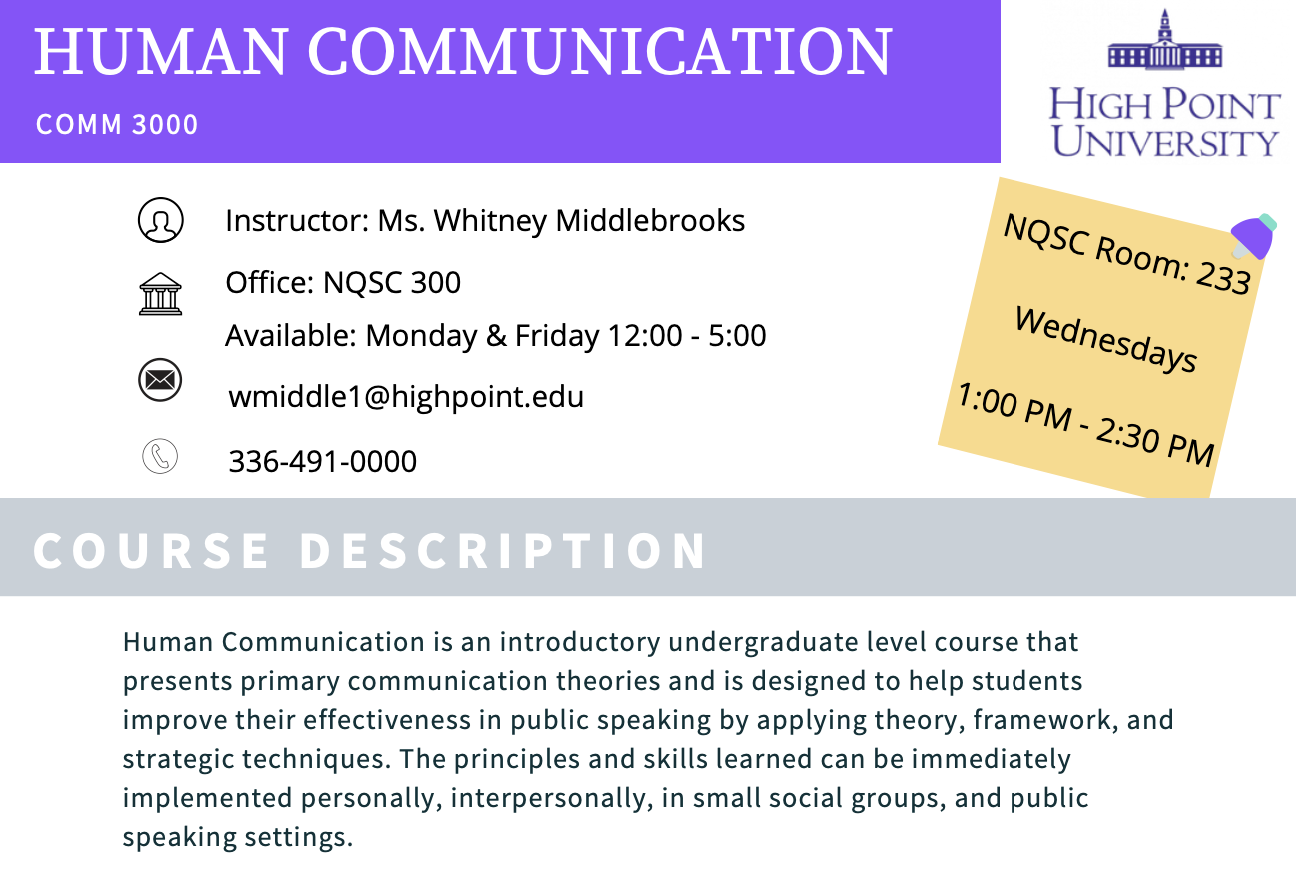Teaching in Higher Education
PROJECT DETAILS: This project was administered while obtaining my Master's in Strategic Communications at High Point University, guiding students relevant to Health Communication Campaigns on eHealth and Mobile Health Applications from Health Communication: Theory, Method, and Application by Nancy Grant Harrington. This practicum demonstrated my ability to connect with college-level students and facilitate an engaging and interactive classroom experience.
Engaging Visuals and Presentation Style: I knew capturing the students’ attention was key, so I created a visually engaging presentation with GIFs, graphics, and selective use of text. My goal was to create a flow that encouraged participation, inviting students to share their thoughts rather than passively absorb information. This approach kept the material relevant and engaging, allowing the students to contribute actively.
Active Class Discussions
The lesson was structured as a discussion, allowing students to voice their experiences with mobile health apps. By focusing on a conversational tone and open-ended questions, I created an environment where students felt comfortable participating, turning a traditional lecture into a lively exchange of ideas.
Hands-On Activity: Mobile Health App Design
To bring the lesson to life, I designed a hands-on activity that challenged students to think critically and creatively. Splitting the class into two groups, I provided supplies like markers, sticky notes, and posters, encouraging them to design a mock mobile health app to address a health issue of their choice. This interactive project aimed to:
Apply strategic communication skills to app design.
Improve teamwork, creative thinking, and presentation skills.
Students enjoyed working together, blending strategic thinking with creativity, and presenting their app ideas in a relaxed, competitive environment. Their excitement and ingenuity in designing their apps were clear indicators of the activity's success.
Learning and Growth
Teaching this lesson gave me valuable insights into classroom dynamics and preparation. I learned the importance of testing technology beforehand and maintaining a calm, approachable demeanor to foster trust and openness. This experience has inspired me to integrate more creative activities into future lessons to encourage active participation and a deeper understanding of the material.
Students enjoyed working together, blending strategic thinking with creativity, and presenting their app ideas in a relaxed, competitive environment. Their excitement and ingenuity in designing their apps were clear indicators of the activity's success.
Learning and Growth
Teaching this lesson gave me valuable insights into classroom dynamics and preparation. I learned the importance of testing technology beforehand and maintaining a calm, approachable demeanor to foster trust and openness. This experience has inspired me to integrate more creative activities into future lessons to encourage active participation and a deeper understanding of the material.
Feedback and Future Ideas
The feedback was positive, with students expressing appreciation for the interactive activity and the professor encouraging the possibility of collaboration between the Strategic Communication and Game Design departments to develop a course on interactive health communication. This experience solidified my confidence in teaching at the college level and demonstrated my capability to craft engaging lessons that resonate with students.
Syllabus Development and Instructional Support
In preparing the syllabus for COMM 3000, I focused not only on creating a structured course outline but also on integrating various instructional support materials to enhance the learning experience. My approach combines syllabus creation, supplementary resources, and media tools with a commitment to clear and effective communication, supporting student engagement and academic success.
COMM 3000 Syllabus and Instructional Support Highlights
Preparation and Distribution of Course Materials
In addition to the core syllabus, I prepared and distributed supplementary materials, instructional media, and relevant resources that supported student comprehension and retention. By utilizing engaging media and materials aligned with course content, I ensured that students had access to diverse resources that catered to multiple learning styles and enriched their understanding of key concepts.
Comprehensive Course Syllabus
The syllabus included all essential elements: contact information, course description, required materials, learning goals, class expectations, assignment details, grading scale, and a complete course calendar. This document served as a foundational guide, offering a clear structure and expectations for the course.
Instructional Media and Engagement Tools
To support active learning, I incorporated multimedia and other devices appropriate for course objectives. This included videos, case studies, interactive presentations, and other digital tools designed to engage students actively and encourage them to apply course concepts in meaningful ways.
Assessing Student Learning Outcomes
Conducting appropriate assessment of student learning outcomes is integral to ensuring that course objectives are met. In COMM 3000, I designed assessments aligned with both course and general education goals, including quizzes, project-based assignments, and group activities that measured students' grasp of the material. This multi-faceted approach allowed me to gauge progress accurately, providing feedback that encouraged further growth and application of their learning.
By creating, distributing, and utilizing these instructional materials, I established a supportive, engaging learning environment that prioritized student understanding and academic success, demonstrating my proficiency in delivering effective, well-rounded college-level instruction.
Instructional Media and Engagement Tools
To support active learning, I incorporated multimedia and other devices appropriate for course objectives. This included videos, case studies, interactive presentations, and other digital tools designed to engage students actively and encourage them to apply course concepts in meaningful ways.
Assessing Student Learning Outcomes
Conducting appropriate assessment of student learning outcomes is integral to ensuring that course objectives are met. In COMM 3000, I designed assessments aligned with both course and general education goals, including quizzes, project-based assignments, and group activities that measured students' grasp of the material. This multi-faceted approach allowed me to gauge progress accurately, providing feedback that encouraged further growth and application of their learning.
By creating, distributing, and utilizing these instructional materials, I established a supportive, engaging learning environment that prioritized student understanding and academic success, demonstrating my proficiency in delivering effective, well-rounded college-level instruction.





